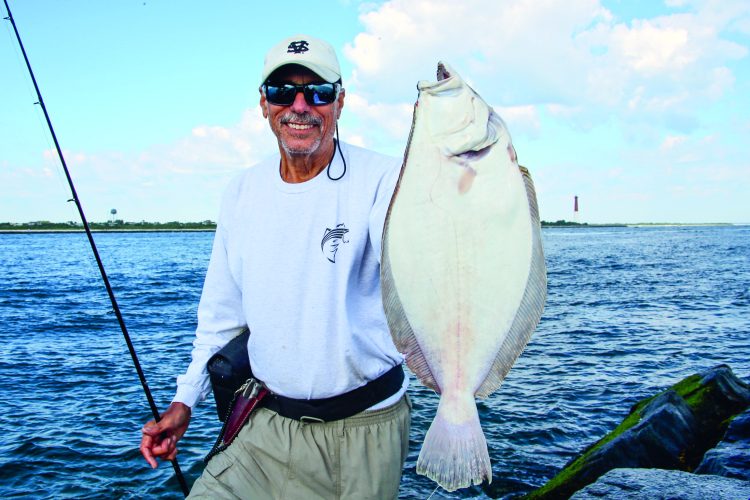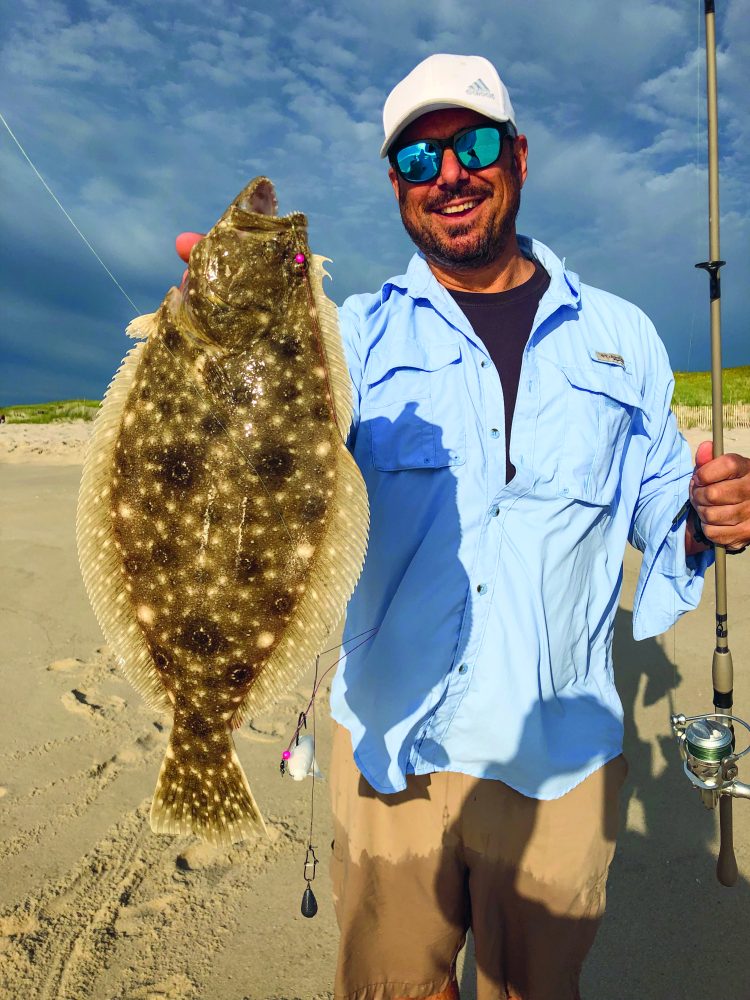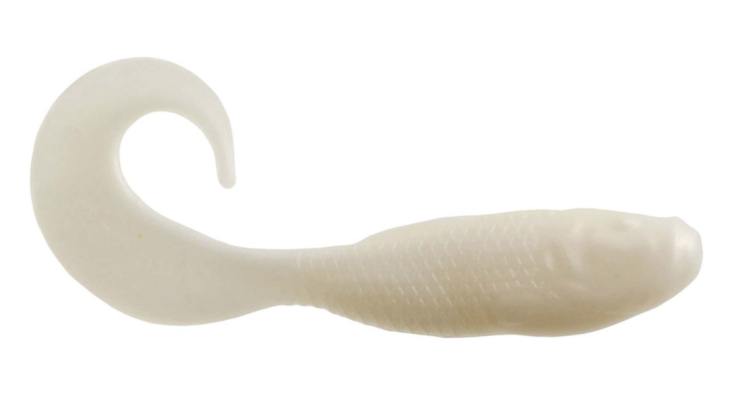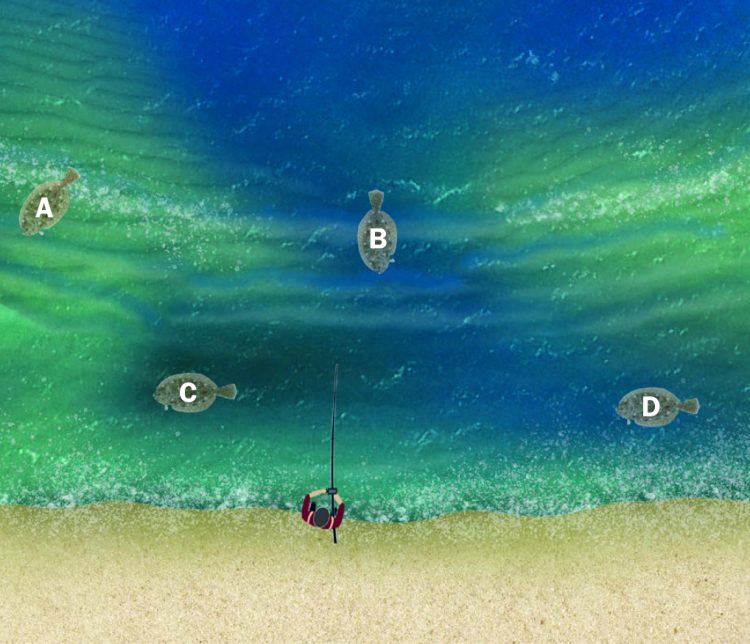Doormat Fluke from the Beach
Surfcasters can find reliable fluke fishing from late spring to fall, right on the beach.

During the past 50 years, I have chased striped bass during the spring and early summer months along my home waters of Ocean County, New Jersey. When the water warms and the stripers move north, I set my sights on the doormat fluke that live within casting range of the surf and jetties. Summer flounder may not fit the profile of gamefish—like hard-fighting striped bass or bluefish—but they are still a worthy fighter and can present a challenge for any angler, pro or novice.
(Note: On The Water is reader-supported. When you buy through links on our site, we may earn an affiliate commission.)
While fluke are most often targeted by boat fishermen, their aggressive nature and unique characteristics make them ideally suited for hunting in the surf zone. Fluke, like flounder, have two eyes on one side of its head, the darker size, that it uses to camouflage on the bottom. Fluke will even bury themselves in the soft, sandy bottom of the ocean, leaving only their eyes exposed. Its near invisibility allows it to easily ambush any prey that washes by in the current.
Early-season flatfish don’t roam very much, so when fishing from the beach, I fan my casts. I take time to read the crashing surf so I can cast over sand bars and work my offering into deeper water where larger fish might be lying. I work a wide area of the shoreline, trying different spots along the beach. Although large doormat fluke are commonly found in 50- to 60- and even 70-foot depths while fishing from boats, I have caught many 3- to 10-pound fluke in 4- to 10-foot depths using simple rigs and light surfcasting setups.

Late spring is the prime time to catch doormat-size fluke from the surf. Summer flounder migrate from offshore to inshore waters, taking up residence where they can ambush prey that is being washed around by the currents. For ambush points, fluke favor structure such as jetties, pilings, docks, inlets, and holes and channel edges of the back bay. They also can be found along the open beaches like Sandy Hook and Island Beach State Park.
Doormat Fluke Rigs for the Surf
For over a half century, my favorite fluke rig has been simple. I use a size 4 three-way swivel with a monofilament drop off it for a dipsey-style sinker, and a 20- to 30-pound monofilament leader with a Gamakatsu octopus-style hook for the bait. Hook sizes vary from 2/0 to 5/0, depending on my choice of bait, and leader length varies from 25 to 40 inches, based on conditions and location.
When working fast-moving water (like inlets), I use a shorter leader to keep the bait from tangling and to stay in the strike zone. In slow-rolling surf, I use a longer leader, which helps the bait appear more natural. Over the last few years, I’ve switched from monofilament leaders to fluorocarbon because of the latter’s lower visibility and enhanced abrasion resistance.
My current fluke rig today has changed some but remains quite simple. I use a leader of 24 to 36 inches, with a dropper loop about 12 to 18 inches above a sinker or bucktail jig.

The Beach Fluke Menu
The most productive bait for catching fluke from the beach varies with the baitfish present throughout the season. Early on, large, live killies (mummichogs) are a top producer when fishing rivers and back bays, and they can also be productive along the surf. Hook the baitfish through both lips and it will survive for a long time. And, its frantic kicking action make it highly effective when current is minimal or nonexistent.
Veteran fluke anglers know the effectiveness of fluke belly strips, and they are my go-to all season long. They have great action, scent, and stay on the hook quite well. I cut the strips 5 to 7 inches long so that they can be seen more clearly as they flutter along the bottom. In New Jersey, anglers can fillet one legal-size summer flounder from their possession limit and use the belly strips as bait, provided they retain the fish’s intact carcass so that it can be measured in compliance with the minimum size limit.
Late in the season, live snapper blues, mullet, and peanut bunker are awesome baits when they become available. I always carry along a cast net late in the season so that I can get a fresh supply of live bait.
Berkley Gulp has changed the way many anglers fish for fluke. This artificial bait has been proven to out-fish natural bait in some cases. One day, I was fishing Barnegat Inlet with fluke belly when an angler next to me was catching fluke on almost every cast using Gulp. Of course, I began using it after that and have been impressed at just how effective it is, and it’s certainly easier to acquire and transport than live or fresh bait. My favorite choice for surfside summer flounder is the 5-inch Gulp swimming mullet in pearl white.

Surf Fluke Conditions
Before making a cast, observe the surf conditions. The wave action will tell you what lies beneath. Indicators such as water color, wave type, and surface motion can help delineate where a feeding fish might be hiding and where to place a cast. Lighter areas indicate shallow water, where fluke hang out on warm, shallow flats waiting for bait to come to them with the current. The shallow water limits the avenues of escape for prey, which means a brief chase and minimal energy exertion.
Areas like troughs between sandbars (or holes between a sandbar and shoreline) provide deeper water for fluke to maintain a feeding position and ambush bait. Along with holes—which are small, subsurface pockets sitting close to the shore—troughs can be identified by darker shading and a lack of foamy water. Because of the depth between shoaling areas, waves will roll over troughs before cresting at the next subsurface structure, such as a sandbar. Keep your eyes peeled for dark-blue stretches of water and waves that don’t crest, since these are indicators of feeding zones for low-lying flounder awaiting a quick meal to be pushed by in the current.
Whatever your chosen tackle and bait for beach-fishing fluke, I recommend that you keep things simple and enjoy yourself.

Before making a cast, observe the surf conditions. The wave action will tell you what lies beneath. Indicators such as water color, wave type, and surface motion can help delineate where a feeding fish might be hiding and where to place a cast. Lighter areas indicate shallow water, where fluke hang out on warm, shallow flats. (A) Waiting for bait to come to them with the current. The shallow water limits the avenues of escape for prey, which means a brief chase and minimal energy exertion.
Areas like troughs between sandbars, (B) or holes between a sandbar and shoreline (C), provide deeper water for fluke to maintain a feeding position and ambush bait. Along with holes—which are small, subsurface pockets sitting close to the shore—troughs (D) can be identified by darker shading and a lack of foamy water. Because of the depth between shoaling areas. waves roll over troughs before cresting at the next subsurface structure, such as a sandbar. Keep your eyes peeled for dark-blue stretches of water and waves that don’t crest, since these are indicators of feeding zones for low-lying flounder awaiting a quick meal to be pushed in by the current.
Tackle for Targeting Surf Fluke
Location is the determining factor in rod, reel, and rig choice when going after fluke from shore. In deeper, moving water like inlets, heavier tackle may be needed than when fishing the open beach.
I use both spinning and conventional tackle for targeting fluke from the surf. I prefer 7- to 8-foot moderate-fast to fast action, high modulus graphite rods. True surfcasting fluke specialists choose rods that are balanced and designed with sensitive action. My go-to in recent seasons has been the St. Croix Legend XTreme 7-foot, medium-heavy rod, which is rated to 1¼ ounces.
I use braided line between 20- and 40-pound test because it offers more strength, sensitivity, and better casting than monofilament. When using conventional tackle, I like reels with a level wind so that I can focus on my presentation without worrying about line lay on the spool.
Doormat Fluke are Closer than you Think!
Fluke often sit just off the beach lip, practically in the white water. Many fishermen quickly reel their presentations right through the most productive area to make another cast, but savvy fluke surfcasters work theirs almost onto the dry sand! Better yet, casting parallel to the shoreline and fan-casting to completely cover an area will ensure you get your bait in front of a fluke whether it’s holding deep in the trough or scarfing down sand crabs just a few feet from the beach.
I work a wide area of the shoreline, trying different spots along the surf. Although “doormat” fluke are found in 50-, 60- and 70-foot depths while fishing from boats, I have taken multiple 10-pound fluke in 4- to 10-foot depths along the surf.
Related Content
10 Reasons You Haven’t Caught a 10-Pound Doormat Fluke
3 on “Doormat Fluke from the Beach”
-
J haines I have had Fluke hit poppers, swimmers, bucktails,and flys while shore fishing for stripers and blues. The biggest surprise was a keeper fluke while trailing my flyline over my shoulder between sand bars, and WHAM! In waist deep water… Excellent article!
-
Zack Voikos I was fishing back in 2008 in West Yarmouth and caught maybe 4 or 5 fluke right on the surface at night. Beautiful evening! Great article!
-
Mark Great article. My go to is a Carolina rifle with a 3/4 or 1 ounce egg sinker. Early in the season I use a #4 wide bend and go up to a 2 when baits get bigger. Live bait, live bait, live bait. And pull it on up til it’s dry. Luck to yall
Leave a Reply